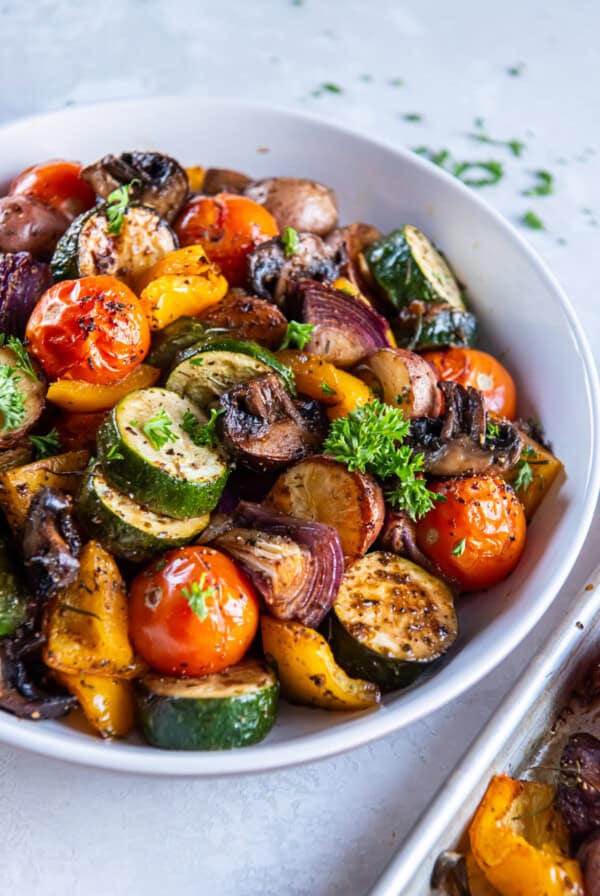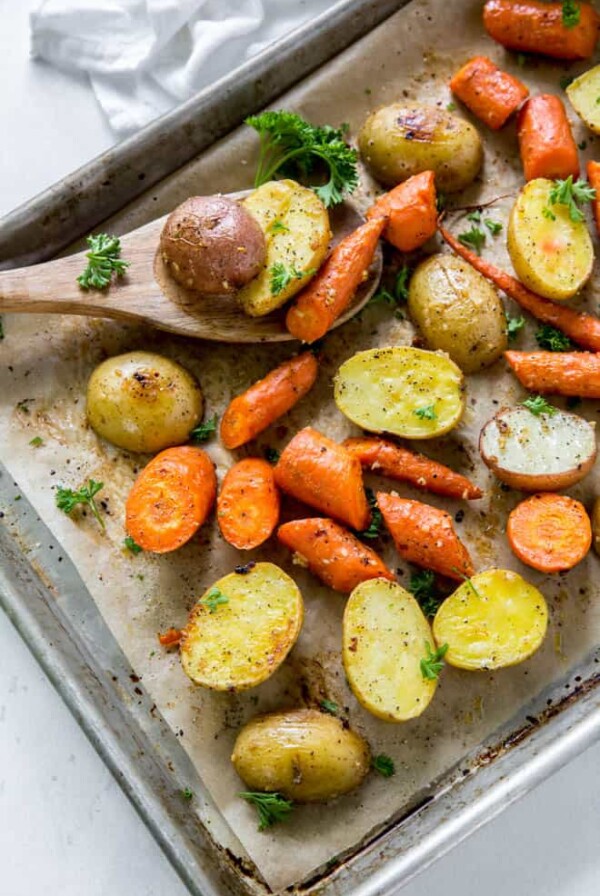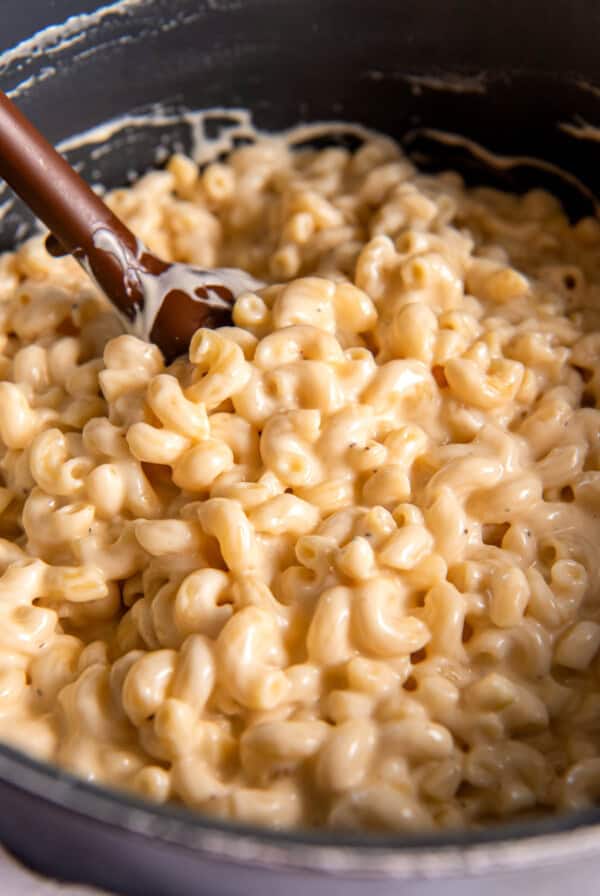This post may contain affiliate links. Please read our disclosure policy.
Learn how to roast vegetables to crispy perfection with this detailed guide! Everything you need to prepare and roast different types of vegetables is included with cooking times and how to mix different veggies.

Roasted vegetables are a great alternative to steamed veggies, especially when you have picky eaters in the family. Roasting intensifies the natural sweetness in vegetables and can often result in irresistible caramelization. As if that isn’t enough, roasting creates crisp outer edges while retaining a fork-tender center.
Quick Tips for Roasting Vegetables
- Select vegetables of similar size or cut them into uniform pieces.
- Do not overcrowd the baking sheet.
- Add vegetables to the oven once it’s preheated.
- Roast vegetables at 425 degrees F until they are fork tender.

Best Vegetables to Roast
- Root Vegetables – Root vegetables are by far the best types of vegetables to roast. They include potatoes (regular potatoes or sweet potatoes), parsnips, beets, turnips and carrots. While butternut squash, pumpkin and acorn squash aren’t root vegetables, their hardy flesh allows for the same cooking time as root vegetables.
- Cruciferous Vegetables – Broccoli, cauliflower, bok choy, cabbage and brussels sprouts are also great choices for roasting.
- Delicate Vegetables – These would be things like zucchini, tomatoes, bell peppers, green beans and asparagus. They all roast very well but require a shorter cook time.
Key Ingredients
Vegetables
The first key ingredient for roasting vegetables are the vegetables themselves! Prepare the vegetables by washing, peeling (optional) and cutting them into uniform smaller pieces for even cooking. You can leave the skin on for added fiber if you prefer.
Make sure the vegetables are firm without any visible spots or blemishes. You can also smell the vegetables for freshness.
Cooking Oil
Once the vegetables have been prepared, toss them in a mild or neutral oil, such as extra virgin olive oil. Other cooking oils could include avocado oil or coconut oil. Adding the vegetables and oil to a mixing bowl will allow you to coat the vegetables well. Don’t be shy to use your hands to gently rub the oil on all surfaces and sides of the cut vegetable.
The vegetable pieces should be glossy from the oil and ready for your choice of seasoning. The oil helps to create a crispy exterior and allows the spices and herbs to stick to the vegetables.
Butter can be used instead of oil if this is your preference. You can use salted or unsalted butter and adjust the seasoning accordingly.
Seasonings
You can keep things simple by seasoning the vegetables with salt. Salt does an amazing job of intensifying the flavor. Black pepper and other seasonings, including dried herbs can also be used to flavor the vegetables prior to roasting.
Powdered garlic, chili powder, curry powder, onion powder, fresh rosemary and thyme work well on roasted vegetables. These suggestions are not exhaustive and you should feel free to experiment with your favorite spices, dried herbs, fresh herbs and seasonings.
Add other flavors like a squeeze of lemon juice or lemon zest, if you wish.
Key Cookware & Tools
Baking sheet
A classic 9×13-inch metal baking sheet will provide enough room for the prepared vegetables to be placed in a single layer. Metal trays also offer better heat distribution compared to glass and ceramic dishes.
Allow enough room on the baking sheet for the vegetables to roast without steaming them. If they are too close, they will steam and not achieve the crisp tender texture.
Parchment paper
Line the baking sheet with parchment paper to prevent the vegetables from sticking to the surface of the tray. It also minimizes mess that you’d need to clean from the surface of the baking sheet.
If you don’t have parchment paper, spray the baking sheet with non-stick cooking spray or line the tray with aluminum foil and lightly spray with non-stick cooking spray on top.

Vegetable Cooking Times
Roast vegetables should be fork-tender with a crispy exterior that has a slightly charred appearance on the outer edges. The cooking times of vegetables differ depending on the type of vegetable, whether it is roasted whole or cut into small pieces and the oven temperature.
The following cooking times are widely accepted for vegetables roasted at a high heat of 425 degrees Fahrenheit and can be used as a general guideline:
- Root vegetables (potatoes, carrots, beets): 30 to 40 minutes
- Other hardy vegetables (squash and onions): 20 to 60 minutes.
- Crucifers (broccoli, cauliflower, cabbage and brussels sprouts): 15 to 25 minutes.
- Delicate vegetables (soft or thin veggies): 10 to 20 minutes
Roasting Mixed Vegetables
You can combine vegetables with protein on a sheet pan dinner like this One Pan Chicken Sausage with Roasted Vegetables and Apples or roast a combination of hardy and soft vegetables in one go, like this Mediterranean Roasted Vegetables or Oven Roasted Green Beans and Potatoes.
Be sure to always start with hardy vegetables and then add the softer vegetables later in the cooking time with the aim to finish roasting all of the vegetables at the same time.

How to Store Roasted Vegetables
Fridge Storage: Store leftover roasted vegetables in an airtight container in the fridge for 3-4 days.
Freezer Storage: Once completely cool, leftover roasted vegetables can be stored in an airtight container or freezer-safe bag for up to 3-6 months. Keep in mind that the texture of vegetables with a naturally higher water content may be altered from freezing and thawing.
Reheating: Leftover roasted vegetables can be reheated in the oven for 10 to 15 minutes. For faster results, add the vegetables to a hot pan with a little oil for 3-4 minutes.
To revive some of the crispy texture of roasted veggies, reheat them in an air fryer for 3-5 minutes a 350 degrees F. Don’t overcrowd the air fryer basket or the vegetables won’t get crispy.
Did you try roasting vegetables? Let us know below by leaving a recipe review and rating.

How to Roast Vegetables
Equipment
- Rimmed baking sheet
Ingredients
- 1-2 pounds any vegetables
- 1 1/2 tablespoons extra virgin olive oil
- Salt and pepper, to taste
- Other seasonings, to taste
Instructions
- Preheat the oven to 425° F. While the oven heats, wash, dry and cut the vegetables into even sized pieces. Smaller pieces will cook more quickly. Larger pieces will take a bit longer.
- Place the vegetables, oil and any seasonings in a large bowl. Toss to coat evenly. Spread the vegetables in an even layer on a rimmed baking sheet lined with parchment paper or foil.
- Roast in the oven until the vegetables are fork tender and slightly browned. Softer vegetables take 10 to 20 minutes to cook while harder vegetables like beets and potatoes will take 30 minutes or longer.
Notes
- Root vegetables (potatoes, carrots, beets): 30 to 40 minutes
- Other hardy vegetables (squash and onions): 20 to 60 minutes.
- Crucifers (broccoli, cauliflower, cabbage and brussels sprouts): 15 to 25 minutes.
- Delicate vegetables (soft or thin veggies): 10 to 20 minutes
Nutrition
Nutrition information is automatically calculated, so should only be used as an approximation.
How to Serve Oven Roasted Vegetables
Roasted vegetables offer a healthy side dish to your favorite protein, including Pan Seared Ribeye, Cast Iron Flank Steak, Creamy Tuscan Garlic Chicken and Oven Baked BBQ Chicken.
Roasted vegetables can also be enjoyed as a complete meal when combined with grains, legumes and other vegetarian ingredients. These Sweet Potato and Black Bean Quinoa Bowls are a great example of that – perfect when catering to those following a vegetarian or vegan diet with a drizzle of balsamic vinegar or your favorite dressing.










Thank you for this! Used this guide to roast a mix of veggies and they came out perfect.
Loving this easy to follow guide. My favorite combo to roast are broccoli, carrots, and potatoes!